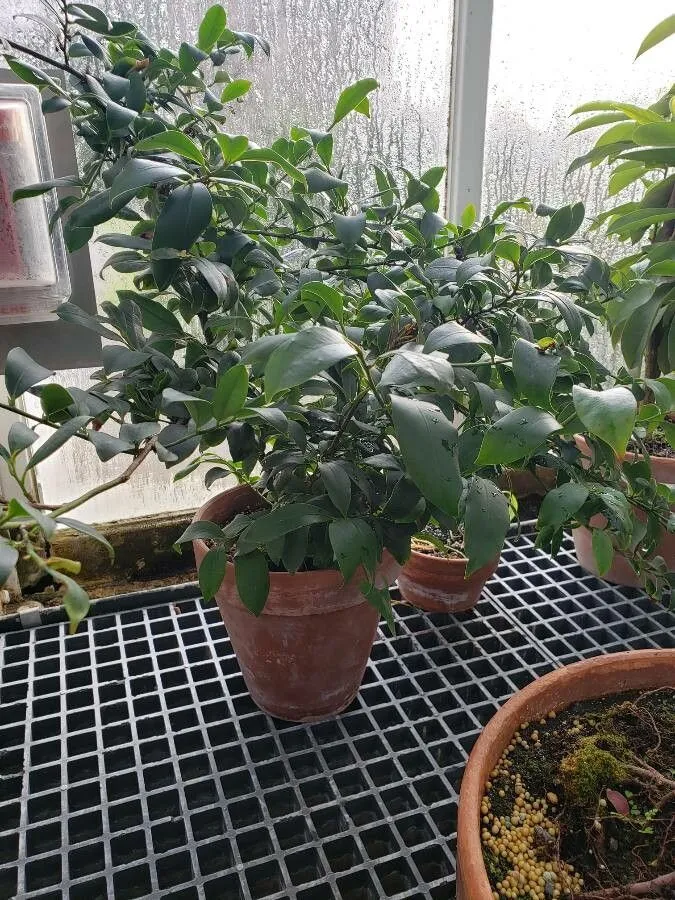
Author: Thunb.
Bibliography: Nov. Gen. Pl.: 69 (1783)
Year: 1783
Status: accepted
Rank: species
Genus: Cleyera
Vegetable: False
Observations: Himalaya to Temp. E. Asia and N. Indo-China, Philippines
Sakaki, scientifically recognized as Cleyera japonica, is an evergreen shrub or small tree that holds significant cultural and botanical value. First documented in the comprehensive work “Nov. Gen. Pl.” by Thunberg in 1783, Sakaki has a wide geographical range, thriving from the Himalayan region to temperate East Asia, North Indochina, and into the Philippines.
This plant is a member of the Pentaphylacaceae family, a group known for its diverse and often ornamental species. Sakaki typically reaches a modest height, characterized by its glossy, dark green leaves that remain vibrant throughout the year. The plant’s dense foliage provides an excellent backdrop for landscaping, often used to create natural screens or garden hedges due to its modest stature and resilience.
Flowering mainly in late spring to early summer, Sakaki produces small, subtle flowers that are usually white or pale yellow. These flowers emit a delicate fragrance, attracting a variety of pollinators, which in turn supports the local ecosystem. Following the flowering season, the plant bears fruit – small, berry-like structures that add an ornamental aspect to its overall appearance.
In terms of cultural significance, Sakaki is deeply entrenched in Shinto practices in Japan. The branches and leaves are frequently used in rituals, symbolizing purity and sanctity. The plant’s enduring greenery represents eternal life and steadfastness, making it a common fixture in shrines and temples. Additionally, Sakaki’s adaptive nature allows it to thrive in varied climates and soils, making it a versatile and resilient specimen for both wild and cultivated environments.
Given its broad ecological footprint from the heights of the Himalayas to the diverse climates of North Indochina and the Philippines, Sakaki exemplifies botanical adaptability. Its ability to thrive across a range of temperate to semi-tropical conditions showcases its robustness and versatility, making it a valuable plant both horticulturally and ecologically.
Eng: sakaki
Swe: spärrbuske
En: Sakaki
Ja: Sakaki
Sv: Spärrbuske
© copyright of the Board of Trustees of the Royal Botanic Gardens, Kew.
© copyright of the Board of Trustees of the Royal Botanic Gardens, Kew.
© copyright of the Board of Trustees of the Royal Botanic Gardens, Kew.
Taken Nov 30, 2021 by William Coville (cc-by-sa)
Taken Jul 26, 2020 by Pereira Jorge (cc-by-sa)
Taken Jun 28, 2020 by Diego Alex (cc-by-sa)
Taken Sep 8, 2022 by Mesquita Filipe (cc-by-sa)
Taken Jun 21, 2021 by Miguel A. García (cc-by-sa)
Taken Nov 30, 2021 by William Coville (cc-by-sa)
Taken Nov 30, 2021 by William Coville (cc-by-sa)
Taken Jun 21, 2021 by Miguel A. García (cc-by-sa)
Taken Jun 21, 2021 by Miguel A. García (cc-by-sa)
Taken Jun 21, 2021 by Miguel A. García (cc-by-sa)
Growth habit>: Shrub
Family: Myrtaceae Author: (F.Muell.) K.D.Hill & L.A.S.Johnson Bibliography: Telopea 6: 402 (1995) Year: 1995 Status:…
Family: Rubiaceae Author: Pierre ex A.Froehner Bibliography: Notizbl. Bot. Gart. Berlin-Dahlem 1: 237 (1897) Year:…
Family: Sapindaceae Author: Koidz. Bibliography: J. Coll. Sci. Imp. Univ. Tokyo 32(1): 38 (1911) Year:…
Family: Asteraceae Author: A.Gray Bibliography: Pacif. Railr. Rep.: 107 (1857) Year: 1857 Status: accepted Rank:…
Family: Fabaceae Author: Medik. Bibliography: Vorles. Churpfälz. Phys.-Ökon. Ges. 2: 398 (1787) Year: 1787 Status:…
Family: Aspleniaceae Author: (Cav.) Alston Bibliography: Bull. Misc. Inform. Kew 1932: 309 (1932) Year: 1932…